Forests provide a range of valuable services—from clean air to beautiful wood products—but none are so fun to make use of as forest foods!
We’ve put together a list of recipes draw from the bounty found in Pacific Northwest forests – both wild and urban lands. Some were offered up or inspired by NNRG members, others collected from sources online.
Where it is safe and legal to forage your own ingredients from a forest or a backyard—at a safe distance from other folks—we recommend doing so for the freshest taste. If you can’t get into the woods safely at this time, look for the asterisk symbols next to the plant names for species that are often found in backyards. Or, put a pin in these recipes for later this year when it’ll be a easier and safer to do some foraging either in a forest near you or at your local farmer’s market.
And remember, always be sure of your plant identification before eating wild foods.
Stinging Nettle
Urtica dioica | Spring | Native
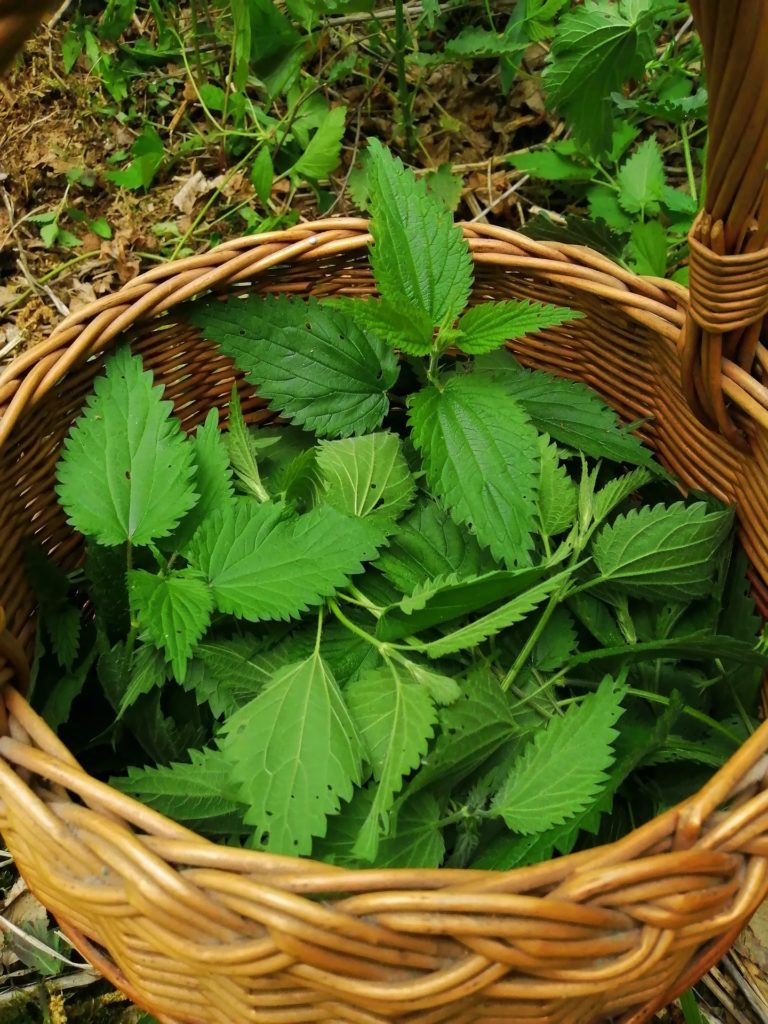
Stinging nettles are common throughout North America, from the coast into the mountains. They are an understory component of riparian communities, and occur in moist sites along streams, forests, and disturbed areas with rich wet soil.
Stinging nettle is a tall deciduous perennial herb. The square stem and serrated opposite leaves are covered with stinging hairs that rise from a gland containing formic acid. It blooms May and June into tiny drooping clusters of flowers.
Stinging nettle leaves, stems, and roots are edible and medicinal. Nettles are considered a superfood and are especially high in calcium, protein, and trace minerals. Young leaves, harvested in early spring, are ideal for eating. Be careful and use gloves when harvesting. Once cooked or dried, nettles completely lose their sting.
Recipes: Stinging nettle soup, Stinging nettle pesto, Stinging nettle beer, Wild nettle hummus, Stinging nettle cordial
Fiddlehead fern
Athyrium filix-femina | Spring | Native
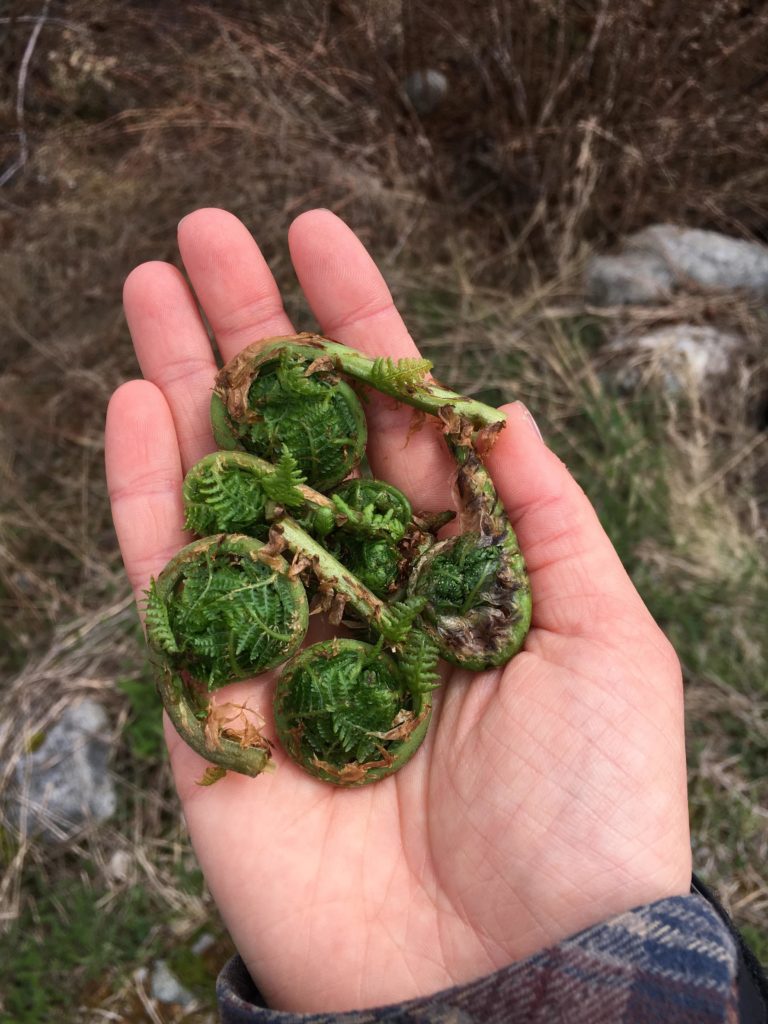
Lady fern is found along the coast and wet interior regions at all elevations of the Northwest, and common in moist areas such as swamps, stream banks, wet forests, and clearings. Lady fern is tall and delicate, with fronds clustered, erect, and spreading from a basal cluster. The leaves are short, scaly at the base, much shorter than the blades; blades are lance-shaped, tapering at both ends. Fiddleheads are the tightly coiled tips of new shoots emerging in early spring.
Fiddleheads should be harvested in early spring when they are still tightly curled. The outside papery chaff should be removed before cooking. Their flavorful taste is described as a cross between asparagus and artichoke. Make sure to cook them thoroughly, as raw fiddleheads contain thiaminase, a vitamin B-depleting enzyme. Heat destroys this enzyme and makes fiddleheads safe to eat.
Tips: Lady ferns aren’t the only edible ferns out there — bracken fern fiddleheads are edible too!
Recipes: Fiddlehead soup, Crunchy pickled fiddlehead ferns, Sautéed fiddlehead ferns, Grilled fiddlehead, Roasted Fiddlehead ferns with Meyer lemon and capers
Japanese knotweed
Fallopia japonica | Spring | Non-native
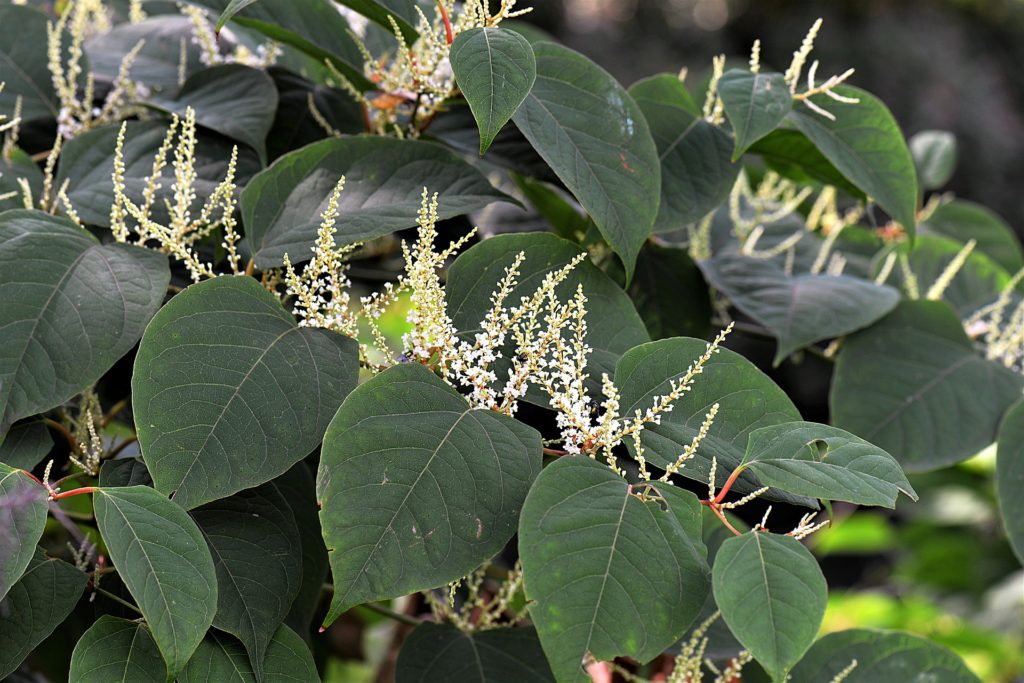
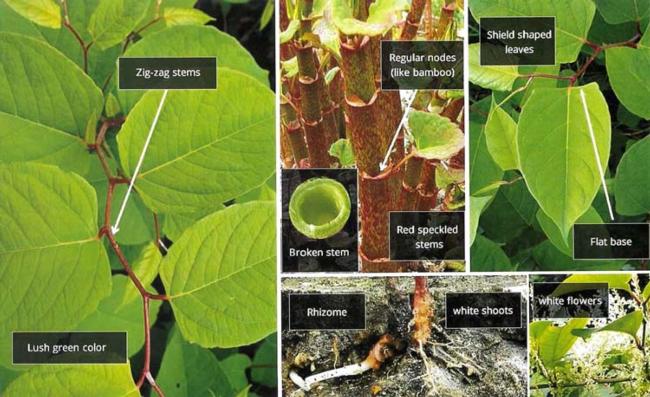
Japanese knotweed tolerates a wide variety of challenging conditions, including deep shade, high salinity, high heat, and drought, but is commonly found near riparian areas, forest edges, meadows, and fields.
One of the most invasive weeds in the world, Japanese knotweed is native to Asia, where it is regarded as having medicinal and edible value. The roots are high in resveratrol, vitamin A, vitamin C, potassium, phosphorous, zinc, and manganese, and are used to help with numerous ailments. The young shoots are edible during the early spring and have a sour, almost rhubarb-like taste. They should be harvested before turning woody, and should be cooked or pickled to remove their oxalic acid.
This plant should be harvested in the Spring, while the canes are still under a foot tall.
Tips: Japanese knotweed roots very easily, even from small cuttings, and extensive cutting of the aboveground shoots can stimulate the belowground rhizomes to grow. Cut sparingly when harvesting, and consult your local Conservation District office for advice on Knotweed removal.
Recipes: Japanese Knotweed Hummus, Sweet and Tangy Knotweed Bars, Japanese Knotweed Syrup, Japanese Knotweed Fruit Leather, Japanese Knotweed Mousse with Wild Mint, Japanese Knotweed Sorbet
Purslane
Portulaca oleracea | Spring to Summer | Non-native
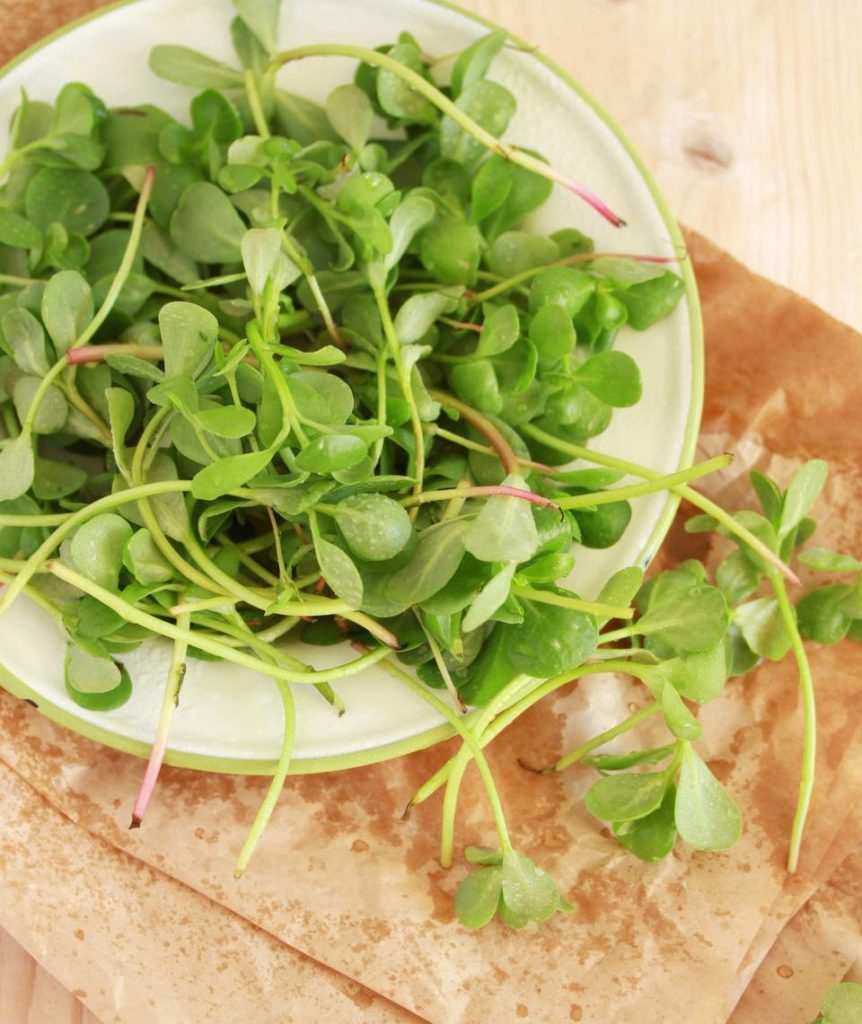
Purslane is a trailing herbaceous annual that is often found thriving in disturbed areas like fields and roadsides. It grows in poor to average, dry to moist soils in full sun. Be sure not to confuse it with the poisonous Hairy-Stemmed Spurge.
It is distinctive for its thick, reddish stem and succulent, green, spoon-like leaves. It blooms from mid-summer though the early fall, and has orange, yellow, red, pink, white, or bicolor flowers that occur singly or in small terminal clusters. When fully open, each flower is about ¼” across, consisting of five petals, two green sepals, numerous yellow stamens, and several pistils that appear together in the center of the flower.
Purslane is highly nutritional. The leaves are a very rich source of omega-3 fatty acids, dietary fiber, iron, magnesium, calcium, potassium, manganese, antioxidants, and vitamins A, C, and B-complex. Young new growth can be eaten as a cooked vegetable and is great to use in salads, soups, stews or any dish you wish to sprinkle it over.
Tips: Purslane often grows in sidewalk cracks and street edges, but—and this should be obvious—it’s best to look for purlane in a wilder setting where you know it’s safe from a) pesticides and herbicides, b) pet urine, and c) other nasty street substances like gasoline.
Recipes: Purslane and Parsley Salad, Sweet Pickled Purslane Stem, Tomato, Cucumber, and Purslane Salad, Purslane Borek, Stir-Fried Purslane, Purslane Smoothie
Salmonberry
Rubus spectabilis | Spring to Summer | Native


Salmonberry is located throughout the Pacific Northwest, yet found mostly west of the Cascades in low to middle elevations. It is common in wet areas like riparian forests, river terraces, and swamps. It is shade tolerant and also found in clearings. Salmonberry is an erect, largely unarmed, branching deciduous shrub, often forming dense thickets. The twigs are zigzag, hairless, and golden-brown with scattered prickles. The sharply toothed leaves are alternate with 3 distinct leaflets consisting of 2 smaller lateral leaflets and one larger terminal leaflet. The circular pink 5 petaled flowers bloom early spring, followed by reddish-orange raspberry-like fruits.
Salmonberry fruits and shoots are edible and highly nutritious. They are a good sources of pro-vitamin A, vitamin C, and antioxidants. Salmonberry shoots are edible in the early spring, and only available for a few weeks when they are tender and juicy and can easily be pinched off either from where they emerge on previous year’s stems or from the ground. They are loaded with minerals and vitamin C, and have a bright tart and astringent taste. The juicy berries are ripe April through June.
Tips: Salmonberry is a useful shrub for restoration work. It transplants easily, with good soil binding qualities once it is established, and is well-adapted to eroded or disturbed sites.
Recipes: Salmonberry cake, Salmonberry jam, Salmonberry syrup, Salmonberry vinaigrette
Dandelion
Taraxacum officinale | Spring to Fall | Non-native
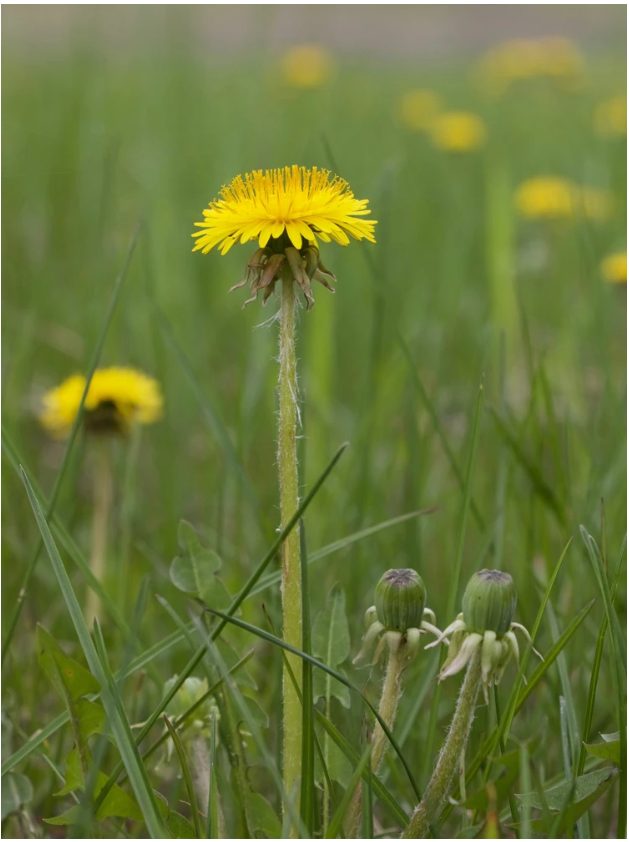
Dandelions are common throughout the Northern hemisphere. Dandelions are a hardy, herbaceous perennial with a rosette base producing several flowering stems and multiple leaves. The leaves generally have toothed edges. The leaves and hollow flower stems grow directly from the rootstock with only one bright yellow flower per stem. The flower heads mature into spherical seed heads containing many single-seeded fruits. Its roots, leaves, and stems all exude a milky white sap.
Dandelion leaves, roots, and flowers are medicinal and edible. The leaves are high in vitamins and minerals, and the roots contain inulin, mucilage, latex resin, and teraxacin. Dandelion leaves can be added to a salad or cooked. They can also be dried and stored or blanched and frozen. Flowers can be made into juice, or added into many recipes. The root can be made into a coffee substitute. Harvest the tender leaves in early spring, buds anytime, flowers when fully open, and roots during the fall.
Tips: Roast dandelion roots and brew like tea for a wild coffee substitute! According to some, it tastes a lot like coffee but less acidic.
Recipes: Dandelion Salad, Dandelion Banana Bread, Dandelion Greens with a Kick, Dandelion Jelly, Dandelion Beer, Dandelion Soda, Dandelion & Chicory Chai
Chickweed
Stellaria media | Spring to Fall | Non-native
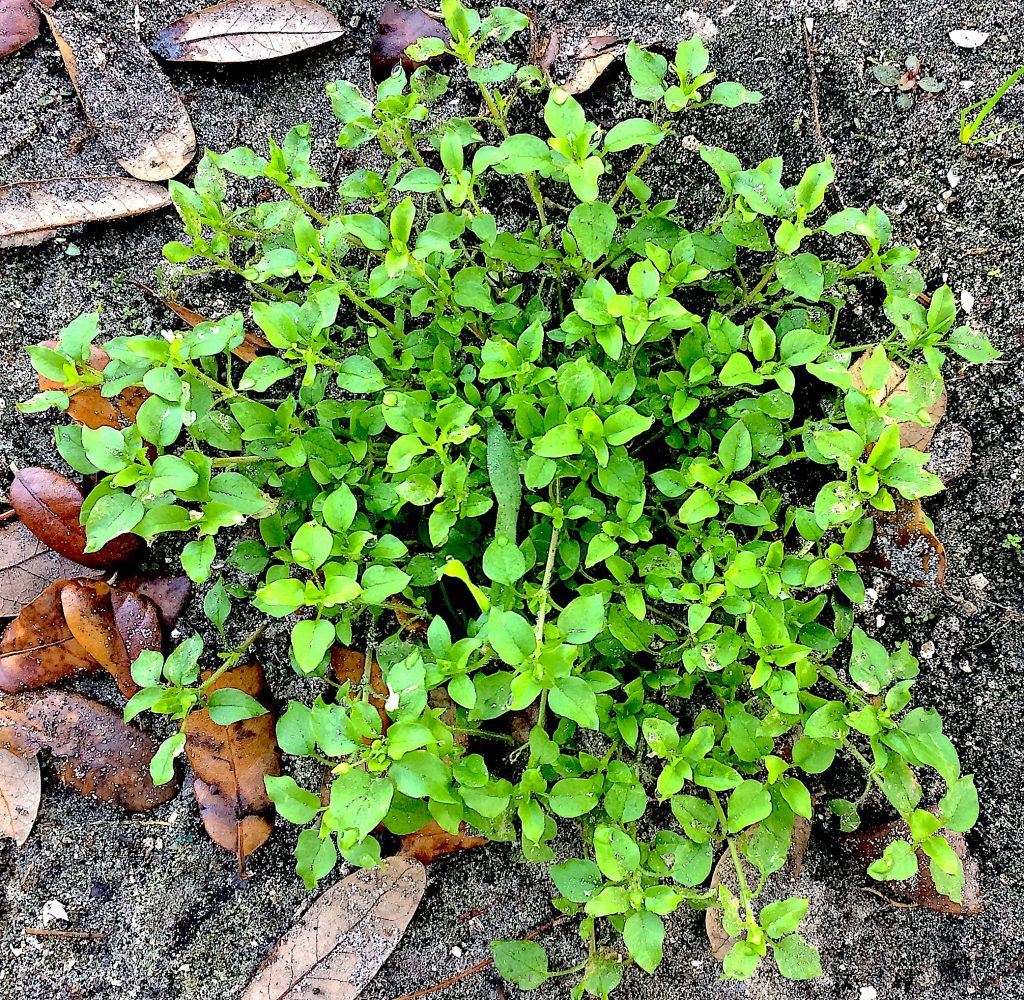
Chickweed is a cool-season annual that grows across North America in a wide variety of habitats and soil textures. It thrives in shady moist corners.
The whole plant will sprawl on flat ground or climb on other plants, and can grow up to 15 inches tall. It has weak slender stems, with hairs in a weave-like pattern only along one side of the stem. The leaves are oval and opposite pairs, and change position at each node. Flowers are small, white, and star-shaped. Seedpods are covered in tiny hairs and droop down.
Young chickweed has a pleasant, mild flavor. It can be blended raw into smoothies, pesto, and sauces. Harvest during the cool spring weather when it is growing rapidly, and during its second flush in the autumn.
Tips: Chickweed is best eaten fresh so plan to use it within a day or so of cutting.
Recipes: Chickweed Pesto, Chickweed Pakoras, Chickweed Salad, Chickweed Coleslaw, Wild Herb Ravioli with Chickweed
Blue Elderberry
Sambucus caerulea | Spring to Fall | Native
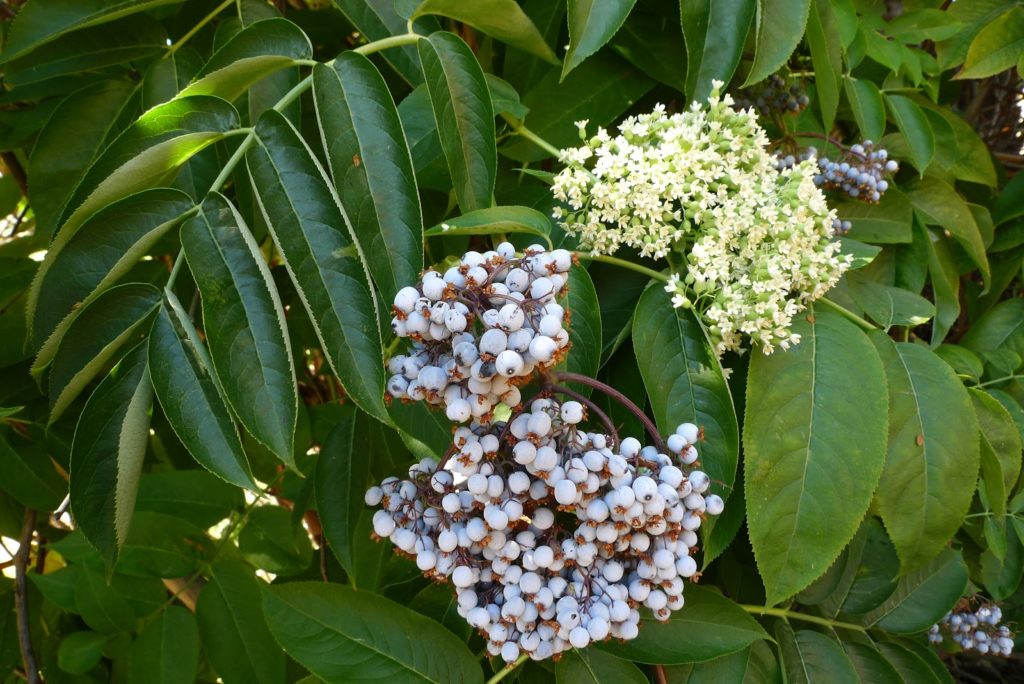

Blue Elderberry is a small deciduous tree found in sunny forest-edges with moist soils, below moderate elevation. They are common along stream banks, river banks, and open places.
Elder grows up to 20 feet high, with many long branches carrying opposite, lance-shaped, toothed leaves. Tiny star-shaped whitish-yellow flowers grow in sprays of dense flat shaped clusters. They bloom in early summer in lowlands and in late summer in the mountains. Deep blue berries develop in August through October and can get heavy enough that they cause branches to droop down toward the ground.
Unripe elderberries are poisonous. Raw berries can cause nausea and other gastro-intestinal upset. But cooked, ripe elderberries are perfectly edible when prepared properly. Elder flowers are harvested in spring when most of the flowers are open and others are budding. Elder berries can be harvested in late summer to early fall. Wait until shiny blue-black berries look powdery.
Tips: Blue elderberries may look more powdery white than blue. This is due to a bloom of naturally occurring yeast that coats the berries and is harmless.
Recipes: Easy Elderberry Syrup, Elderberry Fruit Leather, Elderberry Mead, Elderberry Pancakes, Elderflower Tea, Other Recipes
Salal
Gaultheria shallon | Summer | Native
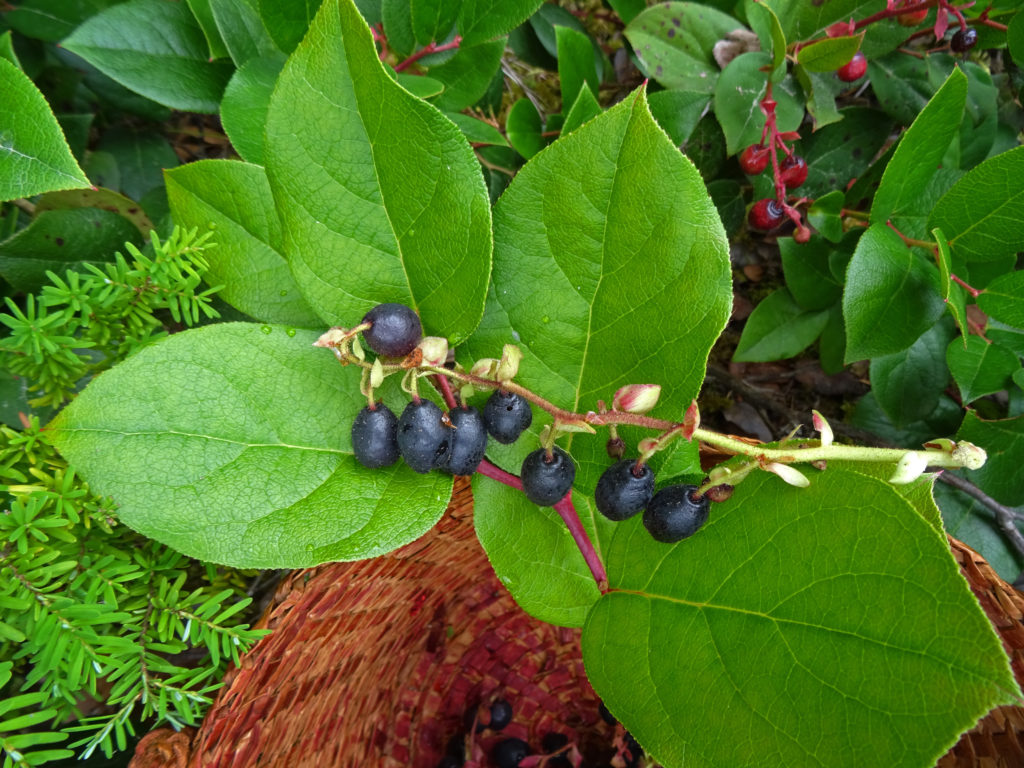
Salal is found throughout the Pacific Northwest in coniferous forests. Salal is an evergreen that creeps into an erect shrub with hairy branching stems and dark, thick, leathery leaves.
Aside from being a popular addition in flower arrangements, salal is harvested for its edible berries and medicinal leaves. The berries are ripe during late summer when they are deep blue, plump and tasty. They can be used raw, cooked, or dried, and can be used like other berries in preserves, pies, drinks, and fruit leather. The leaves are used as a medicine for wounds, coughs, colds, and digestive problems, and can be made into a pleasant tea.
Tips: Don’t have salal in your forest? You can apply for a free use permit to harvest salal for personal use on the Mt. Baker-Snoqualmie National Forest and the Olympic National Forest.
Recipes: Berry Fruit Leather, Salal Berry Jam, Salal Berry Jam with Rosemary, Salal Cranberry Compote
Baldhip Rose
Rosa gymnocarpa | Fall to Winter | Native
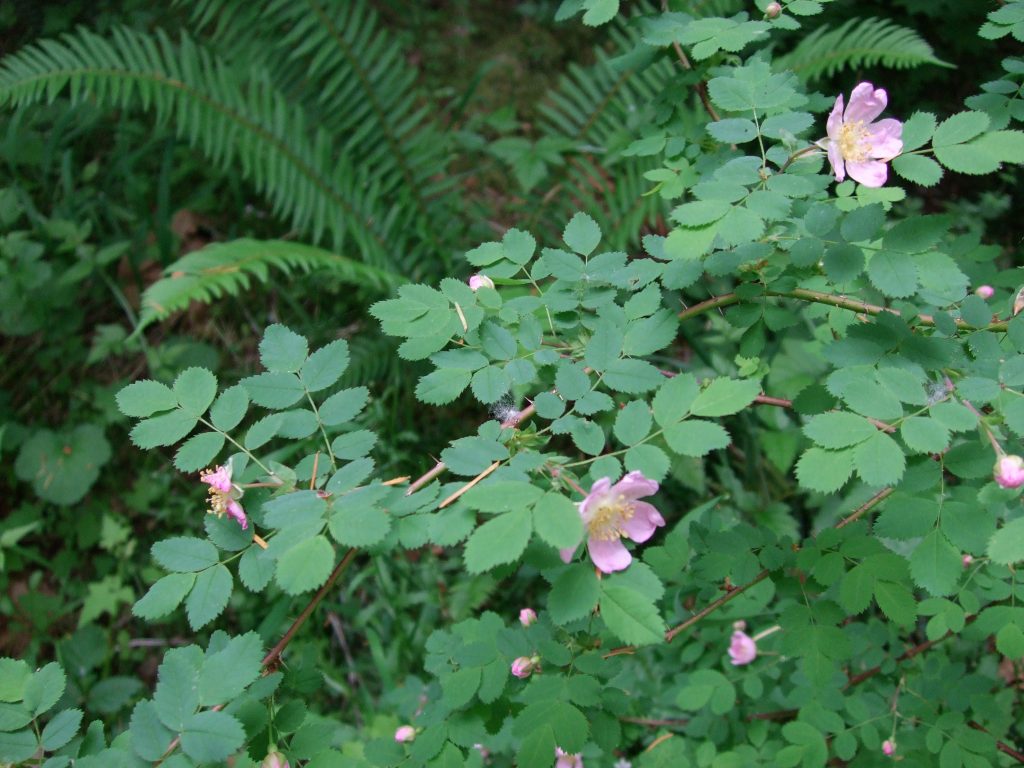
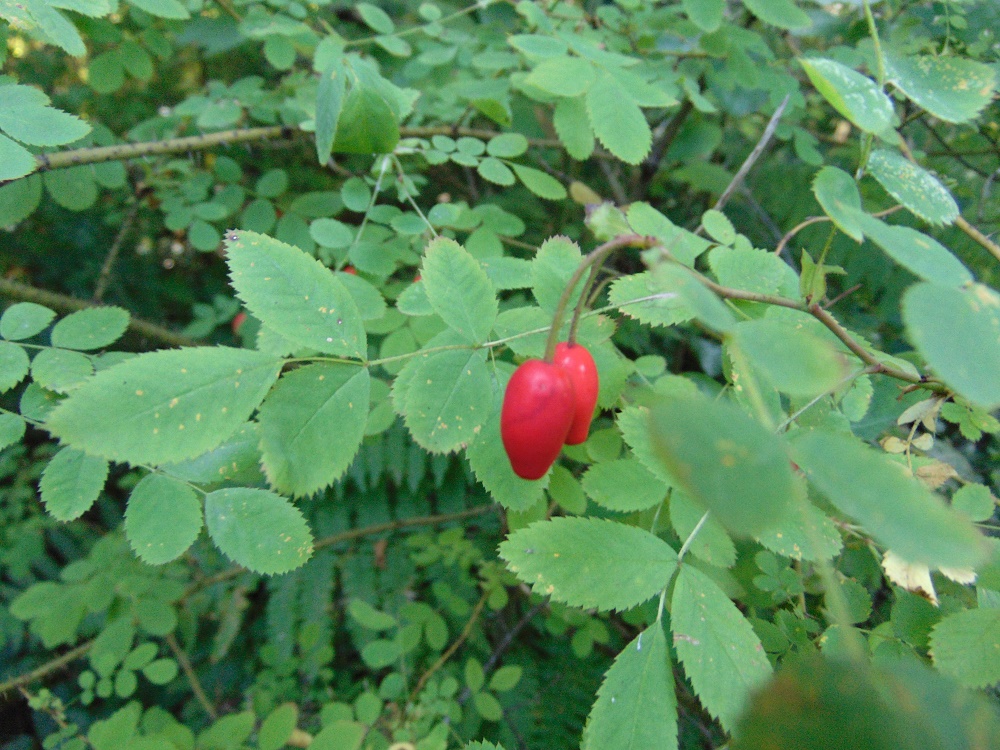
Baldhip rose is located in the moist, shaded understory of Northwest forests in mountainous and riparian areas within eastern and southern exposures. It is a spindly deciduous shrub with brittle weak straight spines. Its leaves are alternate and compound, with an odd number of double-toothed leaflets. Its flowers are pink, single, small, and have 5 petals, and pink-rose in color during May and June. Its fruits are orange to scarlet pear-shaped hips.
Rosehips are used for food and medicine. The hips are high in Vitamins A, B, C, D, and K, calcium, silica, iron, phosphorous and pectin. Be sure to only eat the outer rind, because the seeds contain hairs that are irritating to the digestive tract. Rosehips tea is used for sore throats, colds, diarrhea, and other conditions.
Tips:
Recipes: Cranberry Rosehip Relish, Rosehip Recipes From the Wild, Rose Hip Freezer Jam, Rose Hip Jelly, Rose Hip Cordial, Fermented Rosehip Soda, Rosehip Ketchup, Rosehip Gin
Golden Chanterelles
Cantharelles cibarius | Fall | Native
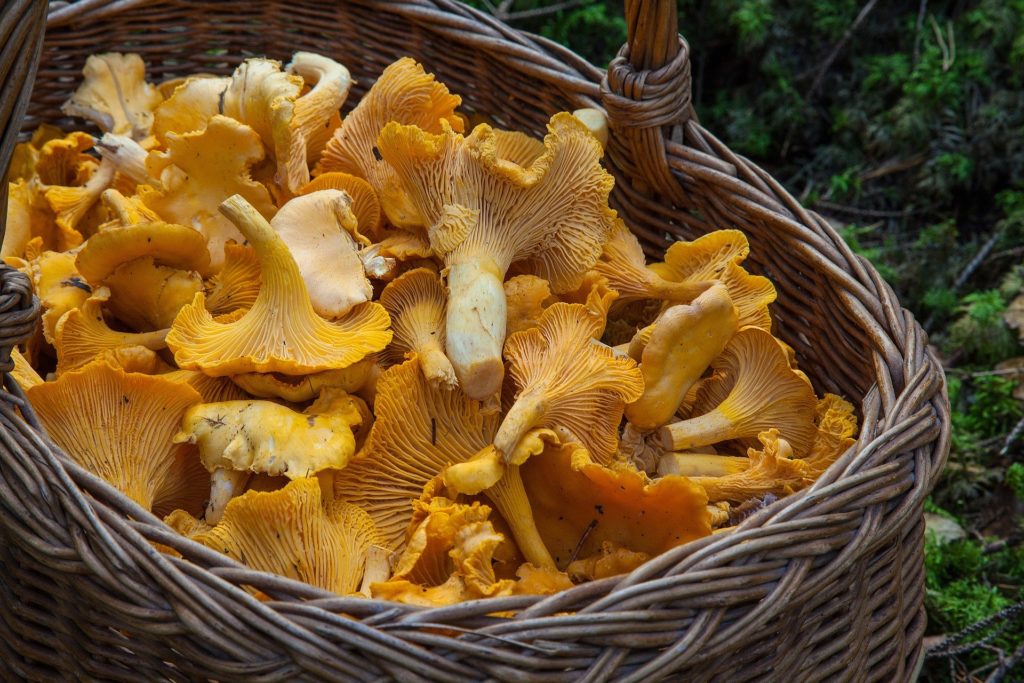
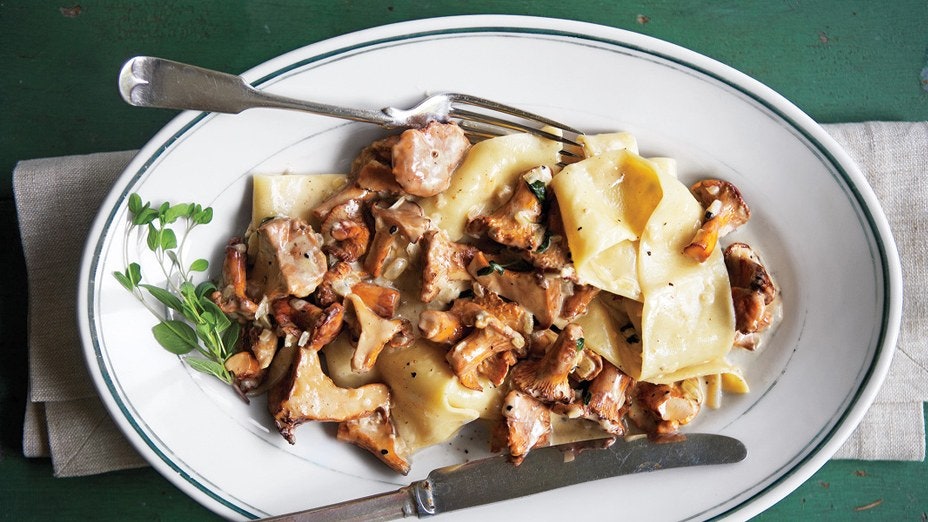
Chanterelles are among the most popular of fungi found in Pacific Northwest. There are several varieties of chanterelles in this area, several of them edible. Golden chanterelles have an earthy, peppery taste and their tan yellow skins make them relatively easy to spot—in theory!
Mushrooming can a be fun, satisfying, and delicious hobby, but knowing how to properly identify edible mushrooms—and avoid toxic or poisonous look-alikes—is the most important component of this activity. Before you go, make sure you know what you’re looking for, and what you’re not looking for. Consult ID guides in books like Wild Edible Mushrooms of the Pacific Northwest. The Mushroom Forager website describes a few of the most common chanterelle imposters, as does Leslie Land. Study up on the imposters and bring some pictures with you if you can.
Tips: Always remember these stern words of warning from Northern Bushcraft: “Do not attempt to identify a mushroom by matching the pictures alone; compare all the listed characteristics. Never experiment with a mushroom that you cannot positively identify, that is over-ripe, damaged, or collected from contaminated areas. Consuming poisonous mushrooms can kill you.”
Recipes: Chanterelles on toast, Fresh Chanterelles with Shallots, Fricassee of Chanterelles, Chanterelle & Fontina Frittata, Haricots Verts with Chanterelles
BONUS recipe from Pam Hayes, steward of FSC®-certified forest Hyla Woods:
Chanterelle Pasta Sauce
INGREDIENTS
chanterelles
white wine
shallots (chopped)
chicken breast
heavy whipping cream
parmesan cheese
salt
pepper
STEPS
1. Clean and chop chanterelles.
2. Dry saute them in a skillet and when they are cooked and most of the liquid has evaporated, add some white wine and let it cook down. Remove chanterelles.
3. In skillet cook chopped shallots and remove. In skillet cook thinly sliced chicken breast meat. Combine Chanterelles, shallots, and chicken in pot.
4. Add heavy whipping cream and simmer until the cream thickens.
5. Serve over pasta with grated Parmesan cheese, pepper, and salt.
Other Great Plants to Eat:
Conifers | Year-round | Native
- Cedar Plank Grilling
- Doug Fir/Spruce Recipes – for spring!
Morel Mushrooms | Morchella | Spring | Native
Garlic Mustard | Alliaria petiolata | Spring | Non-native
Himalayan/Evergreen Blackberry | Rubus armeniacus/laciniatus | Summer | Non-native
Chokecherry | Prunus virginiana | Summer | Native
Red Flowering Currant | Ribes sanguineum | Fall | Native
Oregon Grape | Mahonia aquifolium | Summer | Native
Red/Evergreen Huckleberry | Vaccinium parvifolium/ovatum | Winter | Native
